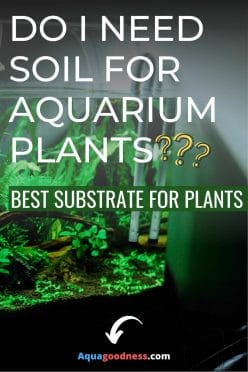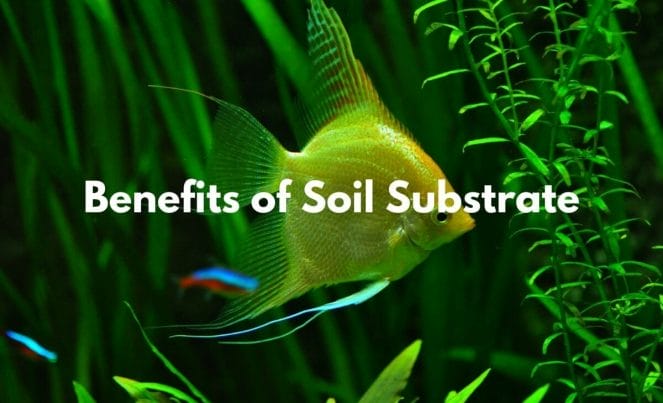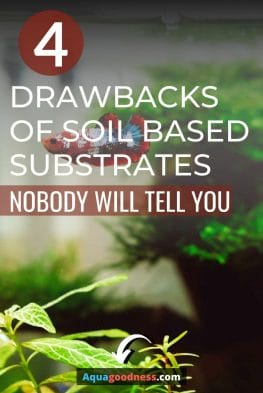Do I need soil for aquarium plants? Many beginners have this question. And in this article, I’m going to answer it.
Read on…

Table of Contents
So do I need soil for aquarium plants?
You can plant live aquarium plants in any substrate whether that is soil, sand, or gravel. You can even keep live aquarium plants in your tank without any substrate.
However, planting the live aquarium plants in soil substrate is beneficial because it provides nutrients to the plants.
Why is it beneficial to plant aquarium plants in soil substrate?

Aquarium plants require several nutrients for their proper growth.
They require micronutrients such as boron, chlorine, iron, zinc, copper, manganese, molybdenum, etc.
Plants require these nutrients in small amounts that’s why they are called micronutrients.
Plants also need nutrients such as nitrogen, phosphorus, calcium, magnesium, potassium, and sulfur.
They require these nutrients in large amounts that’s why they are called macronutrients.
Now in the natural habitat plants get these nutrients from the soil.
That’s why in the very beginning of the aquascaping hobby many aquarists used to keep soil in their aquarium.
However, when you add the soil into the aquarium it makes the water muddy.
So the solution to this problem is covering the soil substrate with a layer of gravel or sand.
Now this solution worked works pretty well if you are not ever going to pull out the plants from the substrate once they’re planted.
But after several years brands like ADA came up with solid-based nutrient-rich substrates.
These substrates are basically small balls of soil so they don’t make your aquarium water muddy.
However, even these substrates break up over time and can make your aquarium water muddy.
Overall, as soil provides essential micro and macronutrients to the plants, planting the live aquarium plants in a soil-based substrate is beneficial.
However not all aquarium plants will benefit from a soil-based substrate.
This is because there are a lot of aquarium plants such as rhizome plants like Anubias and Java fern and stem plants and floating aquarium plants that absorb most of the nutrients through their leaves from the water column.
But there are some live aquarium plants that are known as root feeder aquarium plants that, as the name suggests, absorb most of the nutrients through their roots.
A very popular example of this type of plant is Amazon sword.
Now, these root feeder aquarium plants will definitely benefit if you plant them in a soil-based substrate.
52 Best Freshwater Aquarium Plants For Beginners (And Care Guide)
Drawbacks of soil-based substrate

Though soil-based substrates are good for plants, there’re a few drawbacks of using it.
1. Changes in water chemistry
Soil-based substrates are also called as an active substrate which basically means that it alters the water chemistry of your aquarium water.
And changing the water chemistry can be harmful to the fish in your tank.
2. Makes water muddy
When you keep a soil-based substrate in your tank, over time it will break up in your aquarium. And make the aquarium water muddy.
3. Nutrients will get exhausted
After one or two years, all the nutrients from the soil-based substrate will get exhausted. And then you will need to replenish the substrate again using root tabs which are basically small tablets of fertilizers.
4. Expensive
The Soil-based substrates are quite expensive compared to other types of substrates like sand or gravel substrate.
6 Tips to Take Care of Live Plants in Aquarium (For Beginners)
How to plant aquarium plants in soil?
Planting the live aquarium plants in the soil is a pretty straightforward process.
You just have to hold the roots of the plant with a tweezer and insert it into the substrate.
Just make sure not to bury the plant too much into the substrate, just bury its roots.
Best soil substrate for aquarium plants
I have two soil substrate recommendations for you.
CaribSea Eco-Complete
If you are a beginner and you just want to get started with some live aquarium plants then this is the substrate for you.
It is a very popular substrate and it is so for a good reason.
CaribSea Eco-Complete is basically basaltic volcanic soil substrate.
It contains all the essential micro and macronutrients that plants require for their proper growth such as iron, magnesium, calcium, potassium, sulfur, etc.
It also has a very good CEC value which basically means the ability of the substrate to hold on to the nutrients.
And most importantly, for beginners who just want to get started in the hobby, this is a very good substrate. Because it comes from a reputed brand at a very reasonable price.
Now as with most things, there are some cons with this substrate as well.
The first is, though it contains the nutrients, the amount is not a lot so the nutrients will not last for a long time.
And if you are going to keep a lot of demanding plants then you most likely will need to provide more nutrients using root tabs and liquid fertilizers.
Another thing is the granules of this substrate are sharp so it may scratch the mouth and delicate bellies of the bottom-dwelling fish which can cause bacterial infection.
Check the reviews and latest price of this substrate at Amazon here
ADA Aqua soil Amazonia
If you want to try some advanced stuff then ADA Aqua soil Amazonia is for you.
This soil-based substrate is very popular in the aquascaping hobby.
The reason for that is it contains a ton of nutrients so you can keep very demanding plants in the tank and they’ll grow pretty fast and healthy.
Besides, it also has a very high CEC value so it is very good at holding nutrients.
However, as I mentioned earlier, this substrate is not for beginners, and one of the most important reasons it is not because it leaches a lot of ammonia.
Ammonia is very very harmful to the fish in your tank. And a high ammonia level can even end the life of the fish in your tank.
Besides, after a year or so this substrate will break up which can make your aquarium water muddy.
Also, this substrate is quite expensive.
Check the reviews and latest price of this substrate at Amazon here
Overall, if you are a beginner and you just want some good substrate for keeping some live aquarium plants then you should go for or Caribsea eco complete plant substrate.
On the other hand, if you have some experience in the hobby and you want to keep some demanding plants then Ada Aqua soil Amazonia could be a good choice for you.
Are Aquarium Plant Fertilizers Safe For Fish? (Best fish safe fertilizers)
Can aquarium plants grow without soil?
You can grow most of the aquarium plants without soil. You can plant the plants in substrates such as gravel or sand.
You can even keep some live aquarium plants without substrate which I’ll cover later in this article.
How to keep aquarium plants in sand and gravel substrate?
You can keep most of the live aquarium plants such as rhizome plants, stem plants, and even root feeder aquarium plants in sand and gravel substrate.
How to keep rhizome plants in sand and gravel substrate?
Rhizome plants are the plants, as the name suggests, that have rhizome.
Rhizome plants are great to plant in sand or gravel substrate because these plants don’t absorb a lot of nutrients through their roots from the substrate.
The roots are there so they can get attached to the substrate or anything in your tank.
These plants absorb most of the nutrients through the water column so you will need to supplement them with fertilizers using liquid fertilizers.
13 Best Aquarium Plants For Gravel Substrate
How to plant rhizome plants in sand or gravel?
Planting rhizome plants like Anubias in sand or gravel substrate is also a very straightforward process.
You just have to bury its roots into the substrate and that’s it!
Just make sure not to bury its rhizome.
If you bury the rhizome then the plant will rot and eventually may die.
How to keep stem plants in sand or gravel?
Stem plants also don’t absorb a lot of nutrients from the substrate through their roots.
However, they do absorb some nutrients through the roots. So if you want to plant some stem plant in sand or gravel substrate then you should also provide the nutrients to the plants by inserting some root tabs into the substrate.
Stem plants absorb a lot of nutrients through the water column. So you should also supplement them fertilizers using liquid fertilizers.
8 Best Aquarium Plants for Sand Substrate
How to plant stem plants in sand or gravel?
Planting stem plants into sand or gravel substrate is very easy you just have to bury its roots into the substrate.
Just make sure not to bury the plant too much into the substrate. Just bury its roots because if you bury it too much then it can rot.
Keeping plants in the sand substrate can be challenging if you have fish like oscar fish that like to dig the substrate. Because they can easily uproot the plants.
The trick shown in the video below will help you with this issue.
How to keep root feeder aquarium plants in sand or gravel substrate?
Root feeder aquarium plants are, as the name suggests, the plants that absorb most of the nutrients through their roots from the substrate.
Now, these plants should ideally be planted in a soil-based substrate because a soil-based substrate contains a lot of nutrients.
However, most of the root feeder aquarium plants can also grow in sand or gravel substrate.
You just have to supplement the root feeder plants with fertilizers by inserting root tabs into the sand or gravel substrate.
How to root feeder aquarium plants in sand or gravel substrate?
Planting root feeder aquarium plants is similar to planting stem plants. You just have to bury the roots of the plants into the substrate.
Do Aquarium Plants Grow Better in Sand or Gravel?
How to keep aquarium plants without substrate
Yeah, that’s right! You can keep live aquarium plants without any substrate in your tank.
Rhizome plants
As we have seen earlier rhizome plants don’t absorb nutrients from the substrate.
You can simply attach these plants to any ornaments like driftwood or rock using glue. Or tie them using a fishing line.
Eventually, the roots will get attached to the ornament.
Rhizome plants absorb nutrients through the water column through their lives. So you should provide them nutrients through liquid fertilizers.
Here’s the list of the plants that you can plant on driftwood and rock.
Floating plants
Floating plants are the plants, as the name suggests, the plants that float in your tank.
So obviously, they don’t need any substrate to keep in your tank.
Floating plants are great to provide hiding places for small fish. And they also help to lower the temperature in your tank by blocking the light.
At the same time, as they block the light, you have to be careful with them. Because the plants that are planted in the substrate may not get light.
13 Best Aquarium Plants That Can Grow Without Substrate
Conclusion
It is not necessary to have a soil substrate to keep live aquarium plants in your tank. You can keep most of the aquarium plants without soil substrate.
You can plant the plants in sand or gravel substrate.
Also, you can keep live aquarium plants without any substrate! You can also attach rhizome plants to ornaments in your tank or keep floating aquarium plants.
I hope you found the article helpful.
If you do, please share it.
Thanks for reading.
Happy fishkeeping!
Related articles:

